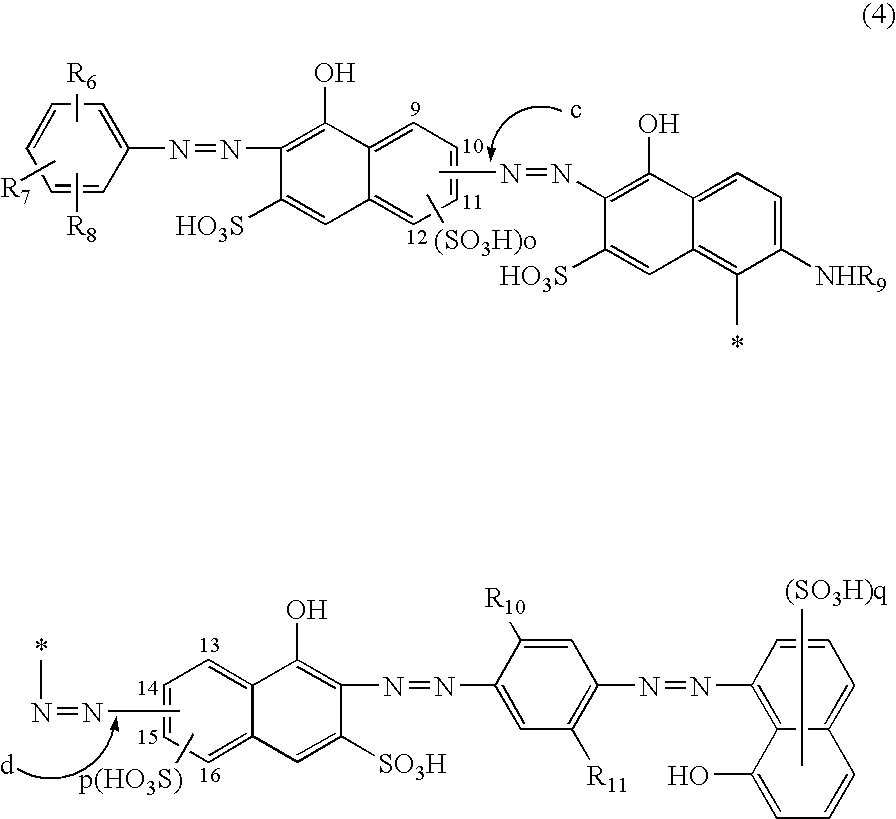Water-base black ink composition and colored material
a technology of black ink and water-base, which is applied in the field of water-based ink composition for inkjet printers, can solve the problems of insufficient performance, technical barriers, and affect image quality, and achieve the effects of improving image quality and reducing production costs
- Summary
- Abstract
- Description
- Claims
- Application Information
AI Technical Summary
Benefits of technology
Problems solved by technology
Method used
Image
Examples
example 1-1
[0156] Into 200 parts of water, 20.42 parts of a compound of Formula (111) as shown below was dissolved while adjusting pH at 5.5 to 8.0 with sodium hydroxide. Next, temperature of said solution was set to 5 to 10° C., and a diazo reaction was conducted by the addition of 52.2 parts of a 35% hydrochloric acid solution and 28.0 parts of a 40% aqueous solution of sodium nitrite thereto.
[0157] This diazo suspension was added dropwise into an aqueous alkaline solution containing 24.7 parts of 7-amino-1-hydroxynaphthalene-3-sulfonic acid in 200 parts of water at 15 to 30° C. During the dropwise addition, pH value of the solution was retained at 8.5 to 9.5 with sodium carbonate. After the end of the dropwise addition, further stirring was conducted for 3 hours at pH of 8.5 to 9.5, at 15 to 30° C., to complete a coupling reaction and to obtain a reaction solution containing a compound of Formula (112) as shown below. Thereafter, salting out thereof was conducted by the addition of sodium...
example 1-2
[0162] The same method as in Example 1-1 was conducted except that 42.0 parts of 7-amino-1-hydroxynaphthalene-3,6-disulfonic acid was used instead of 24.7 parts of 7-amino-1-hydroxynaphthalene-3-sulfonic acid of Example 1-1, to obtain 20.2 parts of an azo compound of Formula (121) as shown below (a compound of No. 2-2 in Table 3). The maximum absorption wavelength in water of this compound was 657 nm, and solubility in water was 100 g / l or more.
example 1-3
[0163] The same method as in Example 1-1 was conducted except that 17.86 parts of 1-amino-2-benzenesulfonic acid was used instead of 20.42 parts of the compound of Formula (111) of Example 1-1, to obtain 18.2 parts of an azo compound of Formula (131) as shown below (a compound of No. 2-3 in Table 3). The maximum absorption wavelength in water of this compound was 650 nm, and solubility in water was 100 g / l or more.
PUM
| Property | Measurement | Unit |
|---|---|---|
| absorption wavelength | aaaaa | aaaaa |
| pH | aaaaa | aaaaa |
| pH | aaaaa | aaaaa |
Abstract
Description
Claims
Application Information
 Login to View More
Login to View More - R&D
- Intellectual Property
- Life Sciences
- Materials
- Tech Scout
- Unparalleled Data Quality
- Higher Quality Content
- 60% Fewer Hallucinations
Browse by: Latest US Patents, China's latest patents, Technical Efficacy Thesaurus, Application Domain, Technology Topic, Popular Technical Reports.
© 2025 PatSnap. All rights reserved.Legal|Privacy policy|Modern Slavery Act Transparency Statement|Sitemap|About US| Contact US: help@patsnap.com



